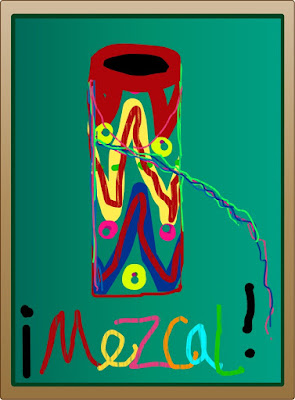As our trip is winding down, we’ve had a chance to reflect
on the past two months and ask ourselves what we really loved about Mexico,
what we learned, and how different the Mexican ways of life that we saw and
participated in were from our own.
 |
| Eric narrowly misses being bussed |
But Mexico does work. At least, that’s what we discovered,
but we had to “bend” a little, duck and weave a little, learn to laugh at
things that just seemed ridiculously crazy, to see how it all fits so
beautifully together.
The linchpin, the thing that holds it all together, is the family, the pervasiveness of it, the fun of it, the comfort, safety and love that is there. From that strong base comes people who are kind, fun-loving, open, honest and curious.
 |
| The festival of the Virgin Dolores was a family affair, as was every other day in Mexico! |
 |
| A little senorita shows off her pretty dress |
 |
| Fathers snuggle with their kids after knocking confetti-filled eggs on each other's heads, Semana Santa tradition |
Of course, this is also the country of drug lords,
corrupt politicians, criminal gangs, revolutionaries and petty thieves, so it’s
not perfect by any means. But, as we found ourselves more immersed in the
families that we met and lived with along the way, we could look past all the
bad stuff and really enjoy the people. We really came to admire their
resilience and patience, their willingness to meet us halfway if we made any
kind of effort to use their language or crack a joke or join in the fun. They
gave these little gifts, regalos, to us all of the time.
 |
| Guadelupe, the Mercado's egg lady |
 |
| Saying farewell to Guadelupe |
Lynn gives flowers to
an egg lady in the town Mercado, three gentlemen stop what they are doing to
talk to us about the importance of certain holidays, they struggle with their
English, we struggle with our Spanish and in the end, hearty handshakes and
kisses on the cheek. A waitress poses for a picture and then gives us her email
along with a goodbye hug. Cab drivers show us the beauty of whatever city we’ve
arrived in. Everywhere, all the time, people greet you with a “buenos dias,”
or ‘tardes” or “noches”. Smiles,
nods, interest, acceptance, humor.
And then the surprises. The sudden explosion of fireworks
for no discernible reason, the eruption of music in the street, a clown
performs on the steps of a building and then… Oh, look, a parade!
For what? A saint, a special day, just because it seems like a good idea… any old reason at all. Flowers grace the feet of statues, or line church steps, or are carried by young men to be given to young women. Mariachi bands perform for patrons eating lunch, while still other bands wait their turn to play for tips (propinas).
The smell of delicious food circles around you.
For what? A saint, a special day, just because it seems like a good idea… any old reason at all. Flowers grace the feet of statues, or line church steps, or are carried by young men to be given to young women. Mariachi bands perform for patrons eating lunch, while still other bands wait their turn to play for tips (propinas).
 |
| Fruit, grains, flowers and all - a surprise for the festival of Dolores |
The smell of delicious food circles around you.
 |
| Oaxaca Mercado |
 |
| Always-smiling produce lady |
In the historic districts the beautiful architecture stands out, the museums filled with old and new art. There are shops for every kind of trinket, blanket, painting, wood carving, t-shirt.
And more surprises and puzzles: In a crèche scene showing the birth of Jesus, not only are there the usual shepherds and wise men, but also figures of baseball players standing guard over the manger. Little offerings include full bottles of coke and bouquets of plastic flowers. What does it mean?
 |
| Baseball player creche |
Buses that are filled to groaning and yet with everyone managing to find room for huge bags of whatever while people hop on and off of the bus, sometimes while its still moving. Beautiful street art side by side with graffiti rendered by unknown hands. It sometimes feels a dreamy movie of some kind of post-apocalyptic yet heavenly cityscape.
And the people we met; our long suffering teacher and master cook Alfonso, our wonderful Oaxacan host family we mentioned in previous posts, Roberto and Blanca from Huatulco, Tom and Deb in San Cristobal, Karen and Ben in Oaxaca, and John and Marlee in Guanajuato, Mexicans and gringos, alike, who were in the swing of things and added much joy and laughter.
 |
| Marlee & John in Dolores Hidalgo |














































